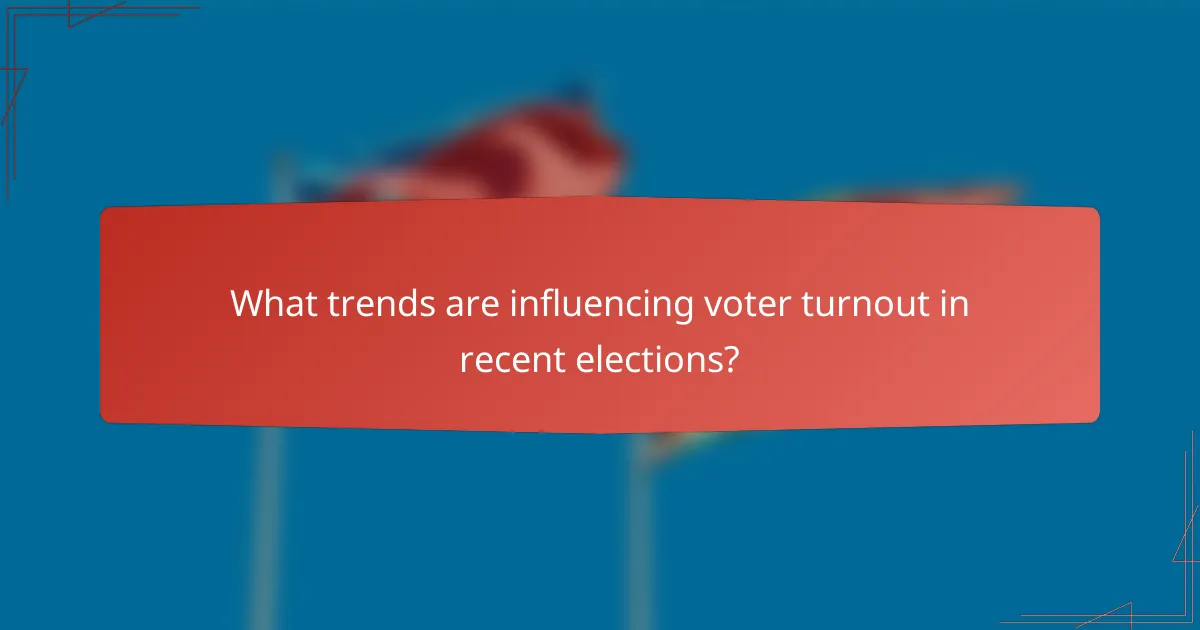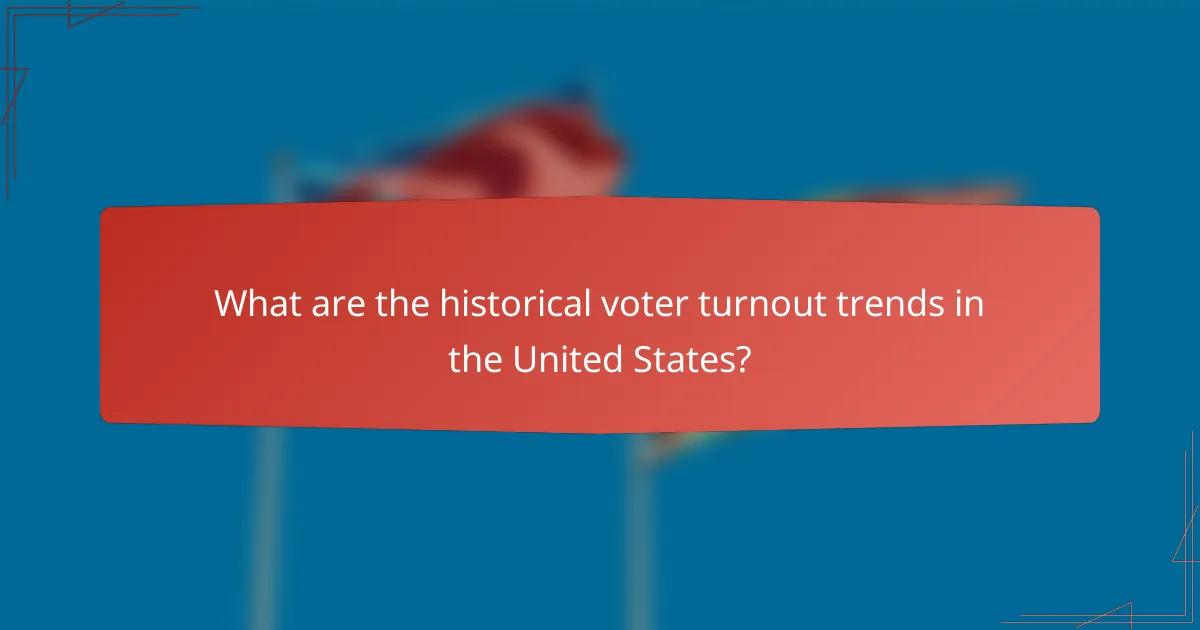Voter turnout is a crucial indicator of democratic engagement, reflecting how effectively citizens participate in the electoral process. By analyzing key metrics such as registration rates and demographic participation, we can identify trends and factors that influence turnout, including social media campaigns and changes in voting laws. Understanding these dynamics is essential for developing strategies to enhance voter participation and strengthen the democratic process.

How can voter turnout be increased in the United States?
Voter turnout in the United States can be increased through several effective strategies that focus on accessibility, education, and engagement. Implementing automatic voter registration, enhancing voter education programs, expanding early voting options, and utilizing technology for voter engagement are key methods to encourage participation.
Implementing automatic voter registration
Automatic voter registration (AVR) simplifies the registration process by automatically enrolling eligible citizens when they interact with government agencies, such as the Department of Motor Vehicles. This approach can significantly increase registration rates, as it removes the burden of manual registration from individuals.
States that have adopted AVR have seen increases in voter registration by tens of percent. It is essential for states to ensure that their systems are secure and that individuals have the option to opt-out if they choose.
Enhancing voter education programs
Voter education programs aim to inform citizens about the voting process, including registration, polling locations, and ballot measures. Effective programs can increase awareness and understanding, leading to higher turnout rates.
These programs can include workshops, online resources, and community outreach initiatives. Collaborating with local organizations can help tailor the education efforts to specific communities, ensuring that information is accessible and relevant.
Expanding early voting options
Expanding early voting options allows voters to cast their ballots before Election Day, which can alleviate long lines and scheduling conflicts. Many states have implemented early voting periods ranging from a few days to several weeks, providing flexibility for voters.
Research indicates that states with more extensive early voting options tend to see higher overall turnout. It is important for states to promote these options effectively to ensure that voters are aware of the opportunities available to them.
Utilizing technology for voter engagement
Technology can play a crucial role in increasing voter engagement through tools such as online registration, mobile apps, and social media campaigns. These platforms can streamline the registration process and provide timely information about elections.
For example, using text message reminders for upcoming elections or deadlines can significantly improve participation rates. However, it is vital to ensure that these technologies are secure and accessible to all demographics to avoid disenfranchisement.

What are the key metrics for analyzing voter turnout?
Key metrics for analyzing voter turnout include voter registration rates, election day participation rates, and the demographic breakdown of voters. These metrics provide insights into how effectively a population engages in the electoral process and highlight areas for improvement.
Voter registration rates
Voter registration rates indicate the percentage of eligible voters who have registered to vote. This metric is crucial because higher registration rates typically correlate with increased voter turnout. In many regions, registration can be completed online, by mail, or in person, with deadlines often set weeks before an election.
To improve registration rates, jurisdictions may implement automatic voter registration or same-day registration policies. For example, countries like Sweden have high registration rates, often exceeding 90%, due to their streamlined processes.
Election day participation rates
Election day participation rates reflect the proportion of registered voters who actually cast their ballots on election day. This metric is essential for understanding the effectiveness of mobilization efforts and the overall health of a democracy. Participation can vary significantly based on factors such as election type, weather conditions, and the competitiveness of races.
In the United States, for instance, participation rates can range from the low 30s for midterm elections to over 60% for presidential elections. Strategies to enhance participation include targeted outreach, early voting options, and mail-in ballots.
Demographic breakdown of voters
The demographic breakdown of voters examines turnout across various groups defined by age, gender, race, and socioeconomic status. Understanding these demographics helps identify disparities in voter engagement and informs strategies to increase inclusivity in the electoral process.
For example, younger voters often have lower turnout rates compared to older populations. In the 2020 U.S. elections, turnout among voters aged 18-29 was around 50%, while those aged 65 and older exceeded 70%. Addressing barriers faced by underrepresented groups can enhance overall voter turnout.

What trends are influencing voter turnout in recent elections?
Recent elections have seen several key trends influencing voter turnout, including the rise of social media campaigns, changes in voting laws, and significant political events. These factors can either encourage or discourage participation, shaping the overall electoral landscape.
Impact of social media campaigns
Social media campaigns have become a powerful tool for mobilizing voters, particularly among younger demographics. Platforms like Facebook, Twitter, and Instagram allow for targeted outreach, enabling campaigns to engage specific groups with tailored messages.
Effective social media strategies can increase awareness about voting dates, registration processes, and candidates’ positions. However, misinformation can also spread rapidly, potentially leading to confusion and decreased turnout if voters feel misled.
Changes in voting laws
Changes in voting laws can significantly impact voter turnout by either facilitating or hindering access to the polls. For example, laws that expand early voting or mail-in ballots typically lead to higher participation rates.
Conversely, stricter voter ID requirements or reduced polling hours may discourage certain groups from voting. It’s essential for voters to stay informed about local regulations, as these can vary widely between states and can change from one election cycle to the next.
Effects of major political events
Major political events, such as presidential elections, significant legislation, or national crises, can dramatically influence voter turnout. High-stakes elections often see increased engagement as voters feel their choices have a direct impact on their lives.
Additionally, events like protests or social movements can galvanize public interest in voting, particularly among marginalized communities. Understanding the context of these events can help predict turnout trends and inform campaign strategies.

How does voter turnout impact election outcomes?
Voter turnout significantly influences election outcomes by determining which candidates and policies gain support. Higher participation often leads to results that reflect the broader electorate’s preferences, while low turnout can skew results toward more motivated, often less diverse groups.
Correlation with election results
Voter turnout is closely correlated with election results, as higher turnout rates generally favor candidates who appeal to a wider demographic. For instance, elections with turnout above 60% often see a more representative outcome compared to those with turnout below 40%, where specific interest groups may dominate.
In many cases, swing states exhibit this trend, where slight increases in voter participation can shift the balance of power. Understanding these dynamics can help campaigns tailor their strategies to engage underrepresented voters.
Influence on policy decisions
When voter turnout is high, elected officials are more likely to prioritize policies that reflect the interests of the majority. This is because they recognize that a larger, more diverse electorate demands accountability and responsiveness.
Conversely, low turnout can lead to policies that cater to the preferences of a smaller, often more extreme segment of the population. For example, in local elections with low engagement, niche issues may receive disproportionate attention, sidelining broader community concerns.
Impact on party representation
Higher voter turnout tends to enhance party representation by ensuring that various demographic groups, including minorities and young voters, have a voice in the electoral process. This inclusivity can lead to a more balanced political landscape.
In contrast, low turnout can exacerbate existing inequalities, allowing dominant parties to maintain power without addressing the needs of all constituents. For instance, in regions where turnout is consistently low, one party may monopolize representation, limiting the diversity of perspectives in governance.

What are the historical voter turnout trends in the United States?
Voter turnout trends in the United States have fluctuated significantly over the years, influenced by various social, political, and economic factors. Historically, turnout rates have varied between different demographics and types of elections, reflecting the changing engagement of the electorate.
Turnout rates over the last century
Over the last century, voter turnout in the United States has experienced notable peaks and troughs. In the early 20th century, turnout rates were often above 60%, particularly during presidential elections. However, these rates declined in the mid-century, reaching lows in the 1970s, with participation dropping to around 50% during presidential elections.
Since the 2000s, there has been a gradual increase in voter engagement, with turnout rates for presidential elections often exceeding 60% again, especially in recent elections. Factors such as increased access to voting, heightened political awareness, and mobilization efforts have contributed to this resurgence.
Comparison of presidential vs. midterm elections
Presidential elections typically see higher voter turnout compared to midterm elections. For instance, turnout in presidential elections can range from 55% to 70%, while midterm elections generally attract about 40% to 50% of eligible voters. This discrepancy is often due to the heightened visibility and perceived importance of presidential races.
Midterm elections, while crucial for shaping Congress, tend to receive less media coverage and public attention, which can lead to lower participation rates. Engaging voters through targeted outreach and education about the significance of midterm elections can help improve turnout in these critical contests.

What factors contribute to disparities in voter turnout?
Disparities in voter turnout arise from various factors, including socioeconomic status, access to polling places, and voter suppression tactics. Understanding these elements can help identify barriers that prevent certain groups from participating in elections.
Socioeconomic status
Socioeconomic status significantly influences voter turnout, with individuals from lower-income backgrounds often participating at lower rates. Factors such as education level, employment status, and income can affect a person’s ability to engage in the electoral process.
For instance, those with higher education levels are generally more likely to vote compared to those with only a high school diploma. Additionally, financial constraints may limit access to transportation or time off work, further impacting turnout among lower-income populations.
Access to polling places
Access to polling places is crucial for facilitating voter participation. Areas with fewer polling locations can lead to long wait times, discouraging individuals from casting their ballots. This issue is often more pronounced in urban neighborhoods and rural regions where resources are limited.
To improve access, jurisdictions can consider extending polling hours, increasing the number of voting sites, and providing transportation options for voters. Ensuring that polling places are equipped to accommodate individuals with disabilities is also essential for enhancing turnout.
Voter suppression tactics
Voter suppression tactics can significantly hinder turnout by creating obstacles for specific groups. These tactics may include strict voter ID laws, purging of voter rolls, and limited access to early voting or mail-in ballots.
For example, some states require photo identification to vote, which can disproportionately affect minorities and low-income individuals who may lack such IDs. Awareness and advocacy against these tactics are vital for protecting the right to vote and ensuring equitable participation in elections.



